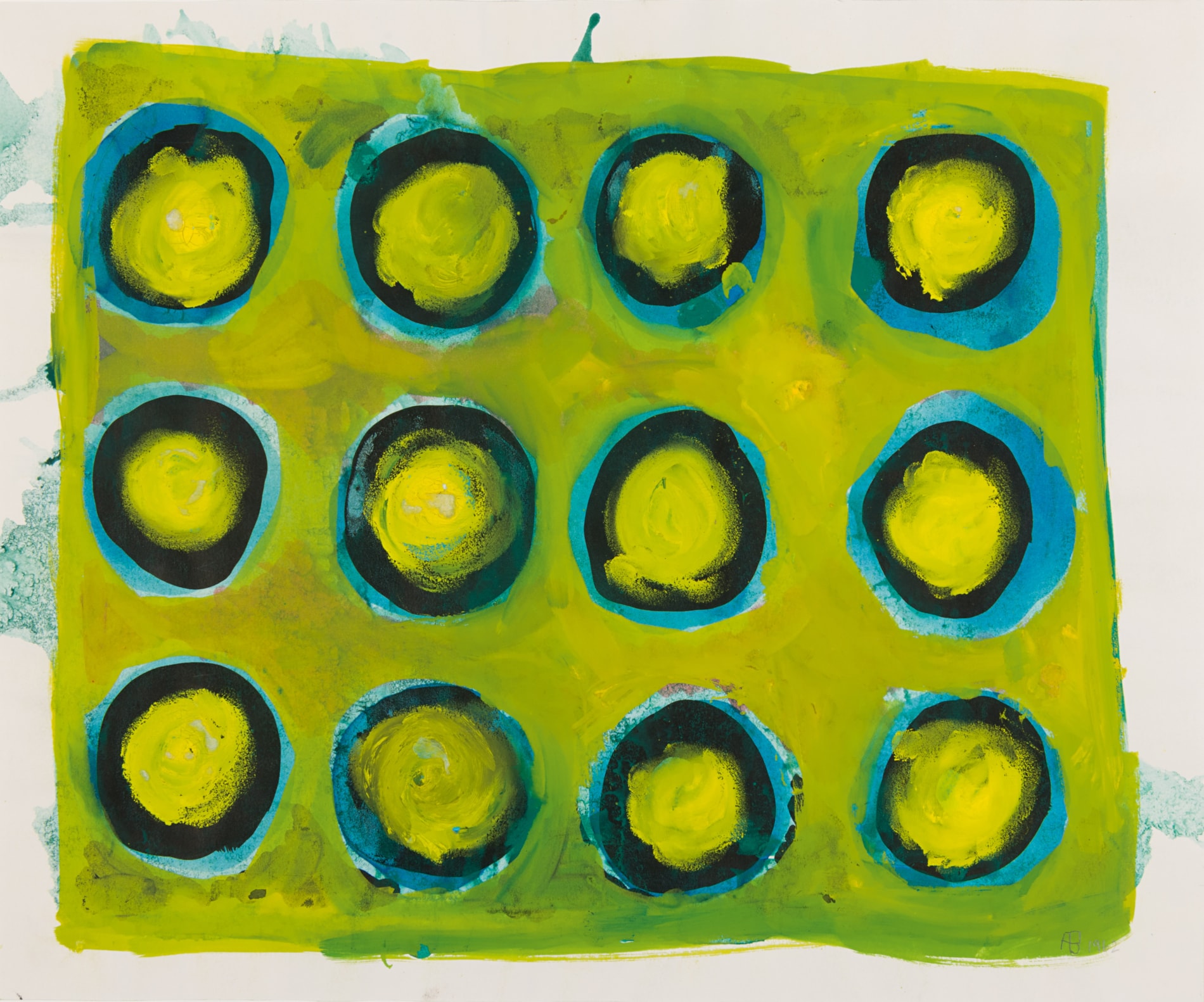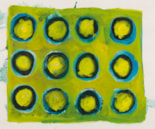Anthony BENJAMIN
(Boarhunt 1931 - London 2002)
Untitled, 1962
Sold
Watercolour, gouache and ink.
Signed with initials and dated AB 1962 at the lower right.
Stamped with the Benjamin estate stamp (not in Lugt) and the date 1962 on the verso.
290 x 350 mm. (11 3/8 x 13 3/4 in.)
Signed with initials and dated AB 1962 at the lower right.
Stamped with the Benjamin estate stamp (not in Lugt) and the date 1962 on the verso.
290 x 350 mm. (11 3/8 x 13 3/4 in.)
During his stay in Italy between 1960 and 1961 Benjamin was especially interested in the art of the Early Renaissance, and in particular the repeated use of flat geometrical shapes in many of the works he admired, such as the rows of saint’s haloes in Duccio’s famous Maestà altarpiece in the Duomo in Siena, painted in the early 14th century. The memory of such a work, with its recurring pattern of haloes within a shallow space, can perhaps be seen in the composition of the present sheet, as well as in a large abstract painting of a similar motif, entitled Senius and likewise dated 1962, in the collection of the Manchester Art Gallery. The painting, acquired by the museum in 1973, measures 152.4 x 157.5 cm.
Born in Hampshire, Anthony Benjamin worked in a variety of media including printmaking, drawing and painting, as well as sculpture. He was trained in engineering draughtsmanship at the Southall Technical College and at the Regent Street Polytechnic in London, where he studied in both the sculpture and painting departments. In 1951, during his time at Regent Street, he also studied for three months with Fernand Leger in Paris. Following his graduation in 1954, Benjamin exhibited briefly at Helen Lessore’s Beaux-Arts Gallery before moving to St. Ives in Cornwall, which was at the time a centre for abstract art, in which he was becoming more and more interested. While there, his work was promoted by the artist Peter Lanyon, who encouraged Benjamin to join the Newlyn Society of Artists, and he had his first solo exhibition at the Newlyn Art Gallery in 1958. Throughout his tenure in St. Ives, like many other artists there, Benjamin produced works abstracted from his coastal surroundings, and with a unique dynamism influenced by the American abstract expressionists. He was encouraged in his work by such figures as Henry Moore and Francis Bacon, and his paintings became more colourful and, gradually, more abstract. Benjamin’s time in St. Ives was interspersed with stays in Paris, where he studied printmaking at Stanley William Hayter’s Atelier 17, and in Italy, where he won a travel scholarship and studied between 1960 and 1961. Following his return to London, his work became even more vibrant, and he also began to work in three dimensions, producing sculpture in wood, metal and Perspex. Benjamin was the subject of critically successful exhibitions at the Institute of Contemporary Art in London in 1966 and the Museum of Modern Art in Oxford in 1977, both of which were dominated by his sculptural work.
Always drawn to teaching, Benjamin lectured in both Britain and America; from 1961 until 1973 at Ealing, Ipswich, Winchester, Ravensbourne, Colchester and St. Martin’s School of Art, and in California and several campuses in Canada. His long tenure in North America, between 1967 and 1973, began right when he was on the cusp of success in his native country, and by the time of his return to England his reputation had subsided. Nevertheless, he continued to be productive as a painter and printmaker, and was a fellow of both the Royal Society of Artists and of the Royal Society of Painter-Printmakers. Benjamin died, in relative obscurity, in February 2002. In an obituary of the artist, it was noted that ‘Perhaps it was this belief in a creativity free from the limits of categorisation that led to Benjamin’s work being misunderstood, and too often forgotten. Even in the 1960s, its lack of confinement seemed to make it elusive and uncommercial. However, it was probably the same spirit that ensured Benjamin’s persistent youthfulness and infectious enthusiasm.’ As the artist himself noted, ‘To rationalise my own work is easy, but I don’t want to rationalise it, for in rationalising it one seems to be led by what seems rational.’
Throughout his long career, Benjamin had over twenty-five solo exhibitions across the United Kingdom, Europe and North America. His works can be found in many museum collections, including the Arts Council of Great Britain and the British Council, the Aberdeen Art Gallery and the Glasgow Museum & Art Gallery in Scotland, the Tate Gallery in London, the Museum of Modern Art in New York, the Art Gallery of Western Australia in Perth and the Art Gallery of New South Wales in Sydney, the former Nagaoka Contemporary Art Museum in Japan, and many others.
Always drawn to teaching, Benjamin lectured in both Britain and America; from 1961 until 1973 at Ealing, Ipswich, Winchester, Ravensbourne, Colchester and St. Martin’s School of Art, and in California and several campuses in Canada. His long tenure in North America, between 1967 and 1973, began right when he was on the cusp of success in his native country, and by the time of his return to England his reputation had subsided. Nevertheless, he continued to be productive as a painter and printmaker, and was a fellow of both the Royal Society of Artists and of the Royal Society of Painter-Printmakers. Benjamin died, in relative obscurity, in February 2002. In an obituary of the artist, it was noted that ‘Perhaps it was this belief in a creativity free from the limits of categorisation that led to Benjamin’s work being misunderstood, and too often forgotten. Even in the 1960s, its lack of confinement seemed to make it elusive and uncommercial. However, it was probably the same spirit that ensured Benjamin’s persistent youthfulness and infectious enthusiasm.’ As the artist himself noted, ‘To rationalise my own work is easy, but I don’t want to rationalise it, for in rationalising it one seems to be led by what seems rational.’
Throughout his long career, Benjamin had over twenty-five solo exhibitions across the United Kingdom, Europe and North America. His works can be found in many museum collections, including the Arts Council of Great Britain and the British Council, the Aberdeen Art Gallery and the Glasgow Museum & Art Gallery in Scotland, the Tate Gallery in London, the Museum of Modern Art in New York, the Art Gallery of Western Australia in Perth and the Art Gallery of New South Wales in Sydney, the former Nagaoka Contemporary Art Museum in Japan, and many others.
Provenance
The estate of the artist.




